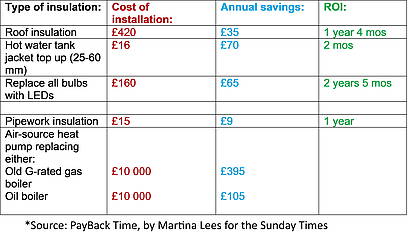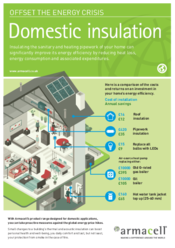How Domestic Insulation Can Help Offset the Energy Crisis
Insulating the sanitary and heating pipework of your home can significantly improve its energy efficiency by reducing heat loss, energy consumption and associated expenditures.
Offset the Energy Crisis by Investing in Your Home
With Armacell’s product range designed for domestic applications, you can take proactive measures against the global energy price hikes. Small changes to a building’s thermal and acoustic insulation can boost personal health and well-being, you daily comfort and last, but not least, your protection from smoke in the case of fire.
Here is a comparison of the costs and returns on an investment in your home’s energy efficiency.
Insulating every loft and cavity wall that needs it would cost the UK £12.5 billion. That would save almost £4 billion a year in bills, enough to pay for itself within three years. What does this look like on a small scale, in your home?
You can optimise the energy efficiency and comfort level of your building in several ways: from making major changes, such as installing an air source heat pump, to small, but important ones – such as insulating all pipework. Cumulatively and over time, pipework insulation plays a significant role in saving you money and prolonging the infrastructure of your residence.
Insulation is a simple, yet powerful way to weather-proof your home, prevent heat loss and moisture ingress, all whilst taking a firm stance against the rising costs of oil and gas. Moreover, changing the ways you keep your home warm and dry can reduce CO2 emissions, maximizing savings for our government and directing the change where it matters the most: UK residents.
In the meantime, here are more tips on how to stop hemorrhaging heat from your home.
1. Water tank and pipe insulation
Dressing your hot water cylinder in a jacket (£16) is a quick job that will save you £70 a year. So will slipping foam tubes around exposed pipes between the cylinder and the boiler. Same goes for the pipework connecting your boiler or AC unit, where these easy-to-install PE Ts and Elbows from Armacell fit the bill perfectly.
2. Roof insulation
A quarter of heat is lost through the roof in an uninsulated home. Lagging with the recommended 27 cm of insulation would cost you £420 for professional installation or half that for DIY. If you had none to begin with, the £35 annual saving will reach your pocket in a little over a year.
3. Cavity wall insulation
Cavity wall insulation is another measure you can take, as walls account for a hefty 25% to 35% of all heat lost from an uninsulated house. If your walls have a cavity of more than 5 cm, fill them up with insulation.
Heat also gets wasted through the pipework that connects your boiler, especially if it sits in an airing cupboard. Instead of using that space as a clothes dryer, insulate the pipework and let that heat spread to where it belongs – your indoor space.
A recent trend amongst both first-time and repeat house buyers has been fueled by the realization the true value of a home lies in its energy efficiency. Today more than ever, with climate change being an increasingly important issue and with an unstable geopolitical situation, energy and water are becoming more precious resources. Pipe insulation is the perfect solution to help you not only reduce the ever-increasing costs but also protect the planet. Replace mineral wool and wood fibre boards – once touted as “breathable materials”, they have little value these days, with modern windowpanes letting in the good stuff and keeping toxins and UV light out. Whilst waiting for the cost of installing an air heat source pump or hydrogen tank to become economically viable to the little guy, install solar panels and insulate your boiler pipes and cavity walls, and you should be ready for the next winter of our discontent.

